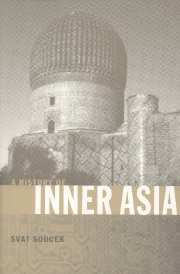Book contents
- Frontmatter
- Contents
- List of maps
- Preface
- Introduction
- 1 The beginnings
- 2 The Kök Turks, the Chinese expansion, and the Arab conquest
- 3 The Samanids
- 4 The Uighur kingdom of Qocho
- 5 The Qarakhanids
- 6 Seljukids and Ghaznavids
- 7 The conquering Mongols
- 8 The Chaghatayids
- 9 Timur and the Timurids
- 10 The last Timurids and the first Uzbeks
- 11 The Shaybanids
- 12 The rise of Russia, the fall of the Golden Horde, and the resilient Chaghatayids
- 13 The Buddhist Mongols
- 14 Bukhara, Khiva, and Khoqand in the seventeenth to nineteenth centuries
- 15 The Russian conquest and rule of Central Asia
- 16 From Governorates-General to Union Republics
- 17 Soviet Central Asia
- 18 Central Asia becomes independent
- 19 Sinkiang as part of China
- 20 Independent Central Asian Republics
- 21 The Republic of Mongolia
- Summary and conclusion
- Appendix 1 Dynastic tables
- Appendix 2 Country data
- Select bibliography
- Index
8 - The Chaghatayids
Published online by Cambridge University Press: 05 June 2012
- Frontmatter
- Contents
- List of maps
- Preface
- Introduction
- 1 The beginnings
- 2 The Kök Turks, the Chinese expansion, and the Arab conquest
- 3 The Samanids
- 4 The Uighur kingdom of Qocho
- 5 The Qarakhanids
- 6 Seljukids and Ghaznavids
- 7 The conquering Mongols
- 8 The Chaghatayids
- 9 Timur and the Timurids
- 10 The last Timurids and the first Uzbeks
- 11 The Shaybanids
- 12 The rise of Russia, the fall of the Golden Horde, and the resilient Chaghatayids
- 13 The Buddhist Mongols
- 14 Bukhara, Khiva, and Khoqand in the seventeenth to nineteenth centuries
- 15 The Russian conquest and rule of Central Asia
- 16 From Governorates-General to Union Republics
- 17 Soviet Central Asia
- 18 Central Asia becomes independent
- 19 Sinkiang as part of China
- 20 Independent Central Asian Republics
- 21 The Republic of Mongolia
- Summary and conclusion
- Appendix 1 Dynastic tables
- Appendix 2 Country data
- Select bibliography
- Index
Summary
About a century after the Mongol invasion, some Chaghatayid khans began to convert to Islam. This tended to happen when they chose to live not in Semireche but in Transoxania, thus among staunchly Muslim populations. True, many of their subjects there were Turks, who had entered that territory since Kök Turkic and Qarakhanid times, and some of whom nevertheless remained nomads and lived in a style not unlike that of the Mongols themselves; but the area's settled population, whether Iranian or Turkic, and whether urban or agricultural, had survived and conserved or recovered the florescence of its Islamic civilization – in contrast, as we have seen, to Semireche.
Islam played a fundamental role in the resilience of native identity and renaissance during these years of Mongol rule, and an especially seminal part was assumed by its Sufi dimension (just as it was to do centuries later during the years of Soviet rule). In the thirteenth and fourteenth centuries, the dominant orders in Mongol Central Asia were the Kubravi and Yasavi tariqas. The Kubravi Shaykh Sayf al-Din Bakharzi of Bukhara can serve as an example.
Shaykh Sayf al-Din Bakharzi had been a disciple of Najm al-Din Kubra in Urgench, the founder of the Kubraviya order of dervishes, who at a critical moment sent him with a proselytizing mission to Bukhara. While Kubra perished during the storming of Urgench by the Mongols, Bakharzi not only survived their seizure of Bukhara but subsequently attained such prestige that the aforementioned Berke (Khan of the Golden Horde, 1257–67), a convert to Islam, came to Bukhara to visit the shaykh.
- Type
- Chapter
- Information
- A History of Inner Asia , pp. 117 - 122Publisher: Cambridge University PressPrint publication year: 2000

